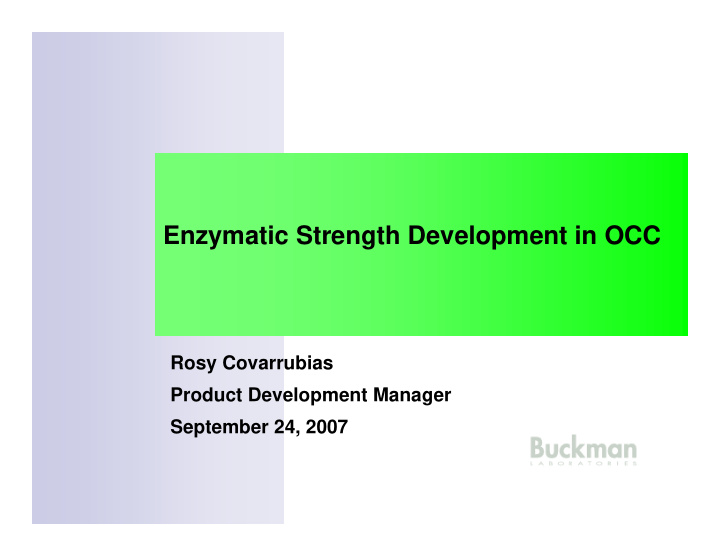



Enzymatic Strength Development in OCC Rosy Covarrubias Product Development Manager September 24, 2007
Agenda � Introduction to Enzymes � Enzymes in the Pulp and Paper Industry � Fiber Modification Enzymes � Strength development in OCC furnishes
Enzymes � Protein catalysts � not used up � specific � Non-living � Reduce energy barrier for specific reactions � Non-hazardous � Biodegradable
Enzymes are true catalysts � They are effective in very small amounts � Only a few molecules of an enzyme will catalyze the conversion of thousands of molecules of substrate to product each second. � They are unchanged by the reaction � The do not affect the ultimate equilibrium concentrations, but reduce the required activation energy and thereby the speed of rections � They are very specific with respect to substrate and reaction
Enzyme activity is influenced by several factors Denaturation T, pH, chemicals Denatured (in-active) Native (active) � Extreme pH, temperature and harsh chemicals can denature/unfold enzymes so that they loose their activity (reversible/irreversible ).
VARIABLES IMPACTING PERFORMANCE OF ENZYME � Contact time � Good mixing at application point � More contact time better efficiency � Temperature � pH conditions � Interfering chemicals � Oxidants
Enzymes in the Pulp and Paper Industry
Pulp & Paper’s Use of Enzymes � The P&P industry, in general, has been fairly slow to accept enzymes for many uses. � ROI vs. Cost was not significant � Enzyme manufacturing methods � Monocomponent vs. mixed enzymes � Raw enzyme costs � Now, the industry is looking to these types of products
Current Paper Industry Enzyme Applications � S � Deposit control tarch conversion � Drainage � S tickies control � Deinking � Pulp pre-bleaching � Charge control � Pitch control � Fiber modification � Boilouts / cleanups
Examples of Enzyme Uses � Proteases - microbio & biofilm cleaning � Amylases - starch system boil-outs � Esterases - stickies control � Lipases - pitch control � Cellulases - fiber modification � Xylanases - bleach reduction / brightness increase � Pectinases –charge reduction increase
Fiber Modification Enzymes
Refining Model Enzyme • Cellulase degrades cellulose in fiber wall structure, initiates wall stripping & fines generation • Refining then delaminate cell walls and cause cell wall to collapse and starts fibrillation which provides the strength of fiber with more bonding sites
Fiber Fibrillation During Refining • Create microfibrils on the fiber surface through fiber wall delamination. • Fibers flatten or collapse and micro-compressions are induced. • Fiber breaks result in decrease in fiber length distribution.
Enzyme Treated Untreated Enzyme Treatment Applied Energy Relative Strength
EFFECT OF BEATING ON PULP PROPERTIES Increase in Value Decrease in Value Breaking Length Tear Index Burst Index Opacity Double Folds Shrinkage Density Air Resistance Sheet Property Burst (Mullen) Fold Tensile Tear Opacity Porosity Refining Energy
Fiber Modification Enzymes � Working with a broad variety of enzymes. � Working primarily with relatively “pure” enzymes. � This enables us to tailor products to various circumstances. � Still in the experimental stages for most applications
Enzymatic Fiber Modification Current Target Applications � Strength modification � Improved softness � Drainage improvements � Vessel segment modification � Opacity variation � Porosity changes � OCC Ring Crush Improvement
Strength Development in OCC
Laboratory Data: Mill A � FIBER : 100% OCC � GRADE : Linerboard � GOAL : Increase ring crush � METHODS : � Enzyme treatment of 1, 2 and 3 lb/ton � Duration 45 min at 140 °F � Prepared 3 gram TAPPI handsheets
Ring crush 34.00 32.00 30.00 28.00 lb/in 26.00 24.00 22.00 20.00 Control (Blank) 1.0 lb/ton BLX-13090 2.0 lb/ton BLX-13090 Bubond 387 6#/ton Bubond 387 6#/ton + 3.0 lb/ton BLX-13090
Tensile Index (Nm/g) 35 33 31 29 27 25 23 21 19 17 15 Control (Blank) 1.0 lb/ton BLX-13090 2.0 lb/ton BLX-13090 Bubond 387 6#/ton
Freeness 300 295 290 285 CSF (ml) 280 275 270 265 260 Control (Blank) 1.0 lb/ton BLX-13090 2.0 lb/ton BLX-13090 Bubond 387 6#/ton
Laboratory Data: Mill B � FIBER : 100% OCC � GRADE : Linerboard � GOAL : Increase ring crush � METHODS : � Enzyme treatment of 2 #/ton for 1 hour at 55 °C � Refined for 2500 revolutions in a PFI Mill � Prepared 3 gram TAPPI handsheets
OCC RING CRUSH Ring Crush Vs Enzyme Treatment 80 78 76 Ring Crush 74 72 70 Control Buzyme 2522 XP04-487W XP04-562W
Case History – Mill A � Grade: Kraft packaging (bag and sack) � Furnish: OCC/DLK � Fourdrinier: 1200 fpm � Production: 100-140 tpd � pH: 7 � Temperature: 130 – 140 °F
Case History – Mill A � Additives � AKD: 2 lb/ton � Fixative: 0.5 lb/ton � PAM: 1 lb/ton � GAP: Reduce DLK usage and supplement with OCC � Critical Tests: Mullen
Case History - Application � Product: BLX 13090 � Dosage: 1 lb/ton � Feed Location: pulper � Contact time before refining: 1 hour
Results � Increased Mullen � Increased drainage � Eliminated DLK usage � Reduced tear, which was negated by: � Reduced refining energy applied � Tear was brought to spec without negating the increases in Mullen
Any Questions? Thank you
Recommend
More recommend